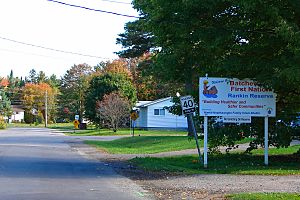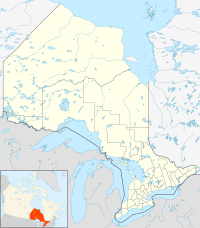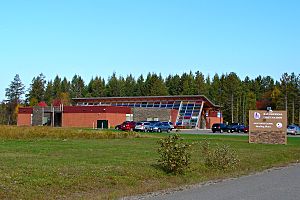Rankin Location 15D facts for kids
Quick facts for kids
Rankin Location 15D
|
|
|---|---|
| Rankin Location Indian Reserve No. 15D | |
 |
|
| Country | |
| Province | |
| District | Algoma |
| First Nation | Batchewana |
| Area | |
| • Land | 15.66 km2 (6.05 sq mi) |
| Population
(2006)
|
|
| • Total | 566 |
| • Density | 36.1/km2 (93/sq mi) |
| Time zone | UTC-5 (EST) |
| • Summer (DST) | UTC-4 (EDT) |
| Website | www.batchewana.ca |
Rankin Location 15D is a special area of land called an Indian reserve. It belongs to the Batchewana First Nation, which is a group of Indigenous people in Canada. This reserve is located in Ontario, near the city of Sault Ste. Marie. It is also close to the Garden River reserve, which belongs to another Ojibwe group.
As of 2005, the Batchewana First Nation had over 2,200 members. About half of these members live on their reserves. Many others live in nearby Sault Ste. Marie.
Contents
Understanding Rankin Location 15D
Rankin Location 15D is the largest of four land areas set aside for the Batchewana First Nation. These areas are called reserves. The Batchewana people's traditional lands used to stretch north from Sault Ste. Marie. This city is known as Bahatwing in their language, Anishinaabemowin.
Other Batchewana Reserves
Besides Rankin, the Batchewana First Nation has three other reserves. These include Whitefish Island in the St. Marys River. There is also Obadjiwan 15E at Batchawana Bay. The fourth reserve is Goulais Bay 15A.
How Rankin Became a Reserve
The Batchewana First Nation bought the land for Rankin in 1939. They wanted to get back some of their historic territory. The Canadian government officially made it a reserve in 1952. This helped the Nation regain a place to live and practice their traditions.
Treaties and Rights
The Batchewana First Nation has important rights related to hunting and fishing. These rights come from a historical agreement called the Robinson Treaty. In 2015, a court case called the Gargantua Harbour Trial confirmed these rights. The court decided that the Batchewana First Nation could continue commercial fishing. They also kept access to a traditional village site through Lake Superior Provincial Park.



